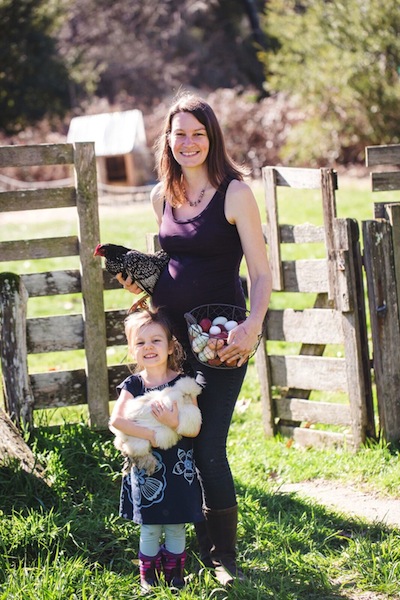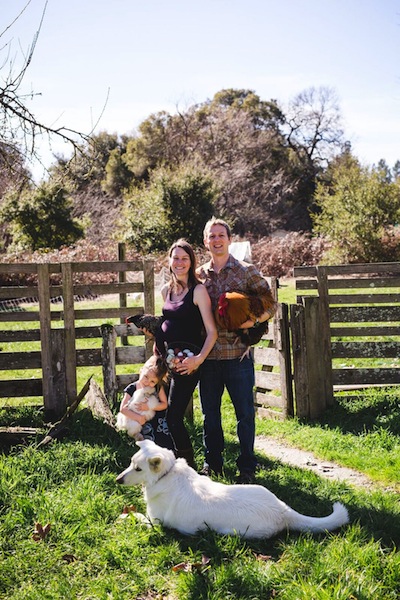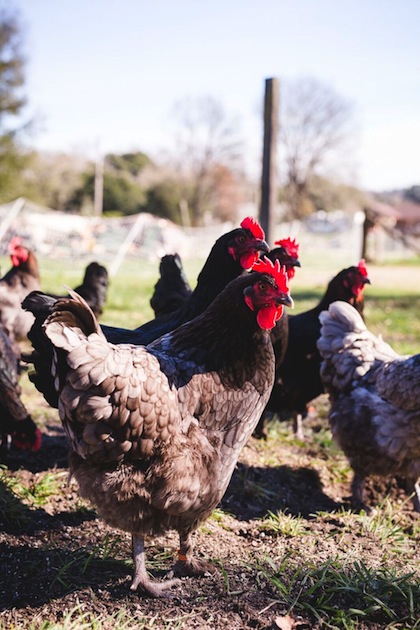At Alchemist Farm, heritage breed chickens come home to roost .
Green Eggs and Ham may be one of the most popular children’s books of all time, but Franchesca Duval, the self-described “head chicken wrangler” at Alchemist Farm and Garden, a small-scale heritage chicken hatchery on the outskirts of Forestville, still spends a good chunk of her time educating her customers about the joy of green eggs.
“A lot of folks, from out-of-state especially, will see our eggs and ask if they can eat the green ones since they’re so used to seeing white eggs in the supermarket,” says Duval, 31, as we walk among 10 different flocks of chickens and roosters spread out across her 31/2-acre homestead. It’s a cold, gray morning in January and a flock of birds with black-and-white geometric patterned wings stand in stark contrast with the green, rain-soaked grass.
Like a modern-day Sam-I-am—if the enthusiastic, top hat adorned Dr. Seuss character was instead a petite brunette, eight-months-pregnant Parker Posey doppelganger—Duval is an enthusiastic cheerleader of green (and cream, blue, and chocolate-colored) eggs and the hearty heritage breed chickens that produce them.
“It’s more interactive and fun to see what nature naturally does, this beautiful rainbow,” says Duval.
Duval lives and works at the farm alongside husband Ryan and four-year-old daughter Trinity. A baby boy, a rooster according to the Chinese horoscope, is due to arrive in April. Duval runs a one-woman operation, where she pasture raises 10 to 12 breeds of chickens at any given time, for a total of 110 birds in the breeding program. That adds up to about 180 chicks hatched a week. The hatching eggs and chicks are then sold locally and across state lines through mail order. The operation is antibiotic and pesticide free and is certified by the Natural Poultry Improvement Plan (NPIP).
The breeds can vary at any given time but, for now, include Double Silver Laced Barnevelders, French Blue Copper Marans, American Breese, and Bantam Silkies. Some are endangered, gone out of style with the industrialization of the food system and the consolidation towards high-producing breeds; the most common layer at larger hatcheries is the Pearl Leghorn, the producer of those familiar white eggs.
“I look for breeds with multiple function,” says Duval. “It has to be a good egg layer that will provide a unique color. And temperament is huge because we have a child who is almost four and we don’t want any mean animals on the property. So, I’m breeding for temperament and personality as well.”
Finally, the chicken absolutely must be heritage breed, something you’d be hard-pressed to find at a larger-scale hatchery. Duval is of the opinion that heritage breeds have good genetics, making them more robust, intelligent, and hardier than the species preferred by industrial poultry operations.
As for the roosters, which are usually tossed into the incinerator at big hatcheries since they aren’t any good as egg producers? Duval runs what she calls a “rooster relocation program,” giving the birds away for free to anyone in Sonoma County willing to raise them for meat or pets.
“I understand monetarily why [the hatcheries] do it, to save feed and space, and people don’t really want roosters,” says Duval, “But nothing is ever killed here needlessly. We call ourselves a humane hatching program, so we offer our male chicks for free to families who want to raise them for food.”
Duval’s interest in chickens started early. As a child, her parents kept a small flock in their backyard in Santa Cruz. She went on to study psychology in college but later found herself poring over research about chickens. (She commonly tags her photos on social media with #crazychickenlady.)
“I knew that when I had my own farm that I would want chickens as part of my infrastructure,” she says.
In March 2015, Duval dove headfirst into the logistics of starting a small-scale hatchery. Initially, her husband suggested an investment in high-production breeds, the white egg layers most of us are familiar with. But Duval had become entranced with more exotic, lesser-known breeds—the layers of blue, green, even chocolate-colored eggs. From there, it was a short leap into the genetics of heritage breed chickens, their robust and hearty constitutions. She began to import hatching eggs from breeders across the country. Before long, she’d built up a diverse, beautiful flock of birds. Chicks hatched at Alchemist Farm have gone on to become backyard chickens for families interested in raising their own eggs and meat, to wineries with a desire for some chicken eye candy, and even to a nursing home in Healdsburg, where the tiny Seramas act as therapy animals to seniors.
With the launch of her business two years ago, Duval became part of an illustrious and proud history of poultry and egg production in Sonoma County. In 1868, a Danish immigrant founded Pioneer Hatchery in Petaluma, the first commercial chicken hatchery in the United States. Later, the town saw the invention of the first egg incubator by Lyman Byce. By the early 20th century, Petaluma proudly called itself the “Egg Capital of the World.” Within decades, with the advent of the corporate industrial food system, the business had all but collapsed. The number of individual egg producers shrunk from 4,000 in 1941 to fewer than 200 in 2017. And actual hatcheries, much less ones that pasture-raise chickens and breed in a humane way, are few and far between. H&N Hatchery, the last hatchery standing in Petaluma, shuttered its doors in 1989. Still, according to the 2015 Sonoma County Crop Report, commercial production of eggs remains a “critical part of the agricultural system,” and accounts for $53.2 million in annual value.
“We’re kind of marrying the old tradition of these hatcheries and egg production that have been in the area forever with this cool new movement which is about getting the best quality of food possible,” says Duval as she strolls past a flock of the Semanas, a bird that originated in Malaysia and might possibly the world’s smallest (and cutest) chicken. “We’re bridging that divide.”
Article resources:
sonoma-county.org/agcomm/pdf/crop_reports/2015_crop_report.pdf



